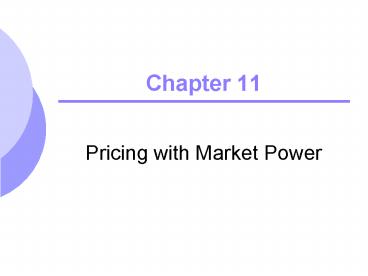Pricing with Market Power - PowerPoint PPT Presentation
1 / 22
Title:
Pricing with Market Power
Description:
Chapter 11 Pricing with Market Power Topics to be Discussed Capturing Consumer Surplus Price Discrimination Intertemporal Price Discrimination and Peak-Load Pricing ... – PowerPoint PPT presentation
Number of Views:64
Avg rating:3.0/5.0
Title: Pricing with Market Power
1
Chapter 11
- Pricing with Market Power
2
Topics to be Discussed
- Capturing Consumer Surplus
- Price Discrimination
- Intertemporal Price Discrimination and Peak-Load
Pricing - The Two-Part Tariff
- Bundling
3
Bundling
- Bundling is packaging two or more products to
gain a pricing advantage - Conditions necessary for bundling
- Heterogeneous customers
- Price discrimination is not possible
- Demands must be negatively correlated
4
Bundling
- Renting the movies separately would result in
each theater paying the lowest reservation price
for each movie - Maximum price Wind 10,000
- Maximum price Gertie 3,000
- Total Revenue 26,000
5
Bundling
- If the movies are bundled
- Theater A will pay 15,000 for both
- Theater B will pay 14,000 for both
- If each were charged the lower of the two prices,
total revenue will be 28,000 - The movie company will gain more revenue (2000)
by bundling the movie
6
Relative Valuations
- If the demands were positively correlated
(Theater A would pay more for both films as
shown) bundling would not result in an increase
in revenue
7
Bundling
- Bundling Scenario Two different goods and many
consumers - Many consumers with different reservation price
combinations for two goods - Can show graphically the preferences of consumers
in terms of reservation prices and consumption
decisions given prices charged - r1 is reservation price of consumer for good 1
- r2 is reservation price of consumer for good 2
8
Reservation Prices
r2
For example, Consumer A is willing to pay up to
3.25 for good 1 and up to 6 for good 2.
r1
9
Consumption Decisions WhenProducts are Sold
Separately
r2
Consumers fall into four categories based on
their reservation price.
r1
10
Consumption Decisions When Products are Bundled
r2
Consumers buy the bundle when r1 r2 gt PB (PB
bundle price). PB r1 r2 or r2 PB -
r1 Region 1 r gt PB Region 2 r lt PB
r1
11
Consumption DecisionsWhen Products are Bundled
- The effectiveness of bundling depends upon the
degree of negative correlation between the two
demands - Best when consumers who have high reservation
price for Good 1 have a low reservation price for
Good 2 and vice versa - Can see graphically looking at positively and
negatively correlated prices
12
Reservation Prices
If the demands are perfectly positively correlate
d, the firm will not gain by bundling. It would
earn the same profit by selling the goods
separately.
13
Reservation Prices
r2
If the demands are perfectly negatively
correlated, bundling is the ideal strategy all
the consumer surplus can be extracted and a
higher profit results.
r1
14
Movie Example
r2
(Gertie)
10,000
Bundling pays due to negative correlation.
5,000
r1
(Wind)
14,000
5,000
10,000
15
Mixed Bundling
- Practice of selling two or more goods both as a
package and individually - This differs from pure bundling when products are
sold only as a package - Mixed bundling is good strategy when
- Demands are somewhat negatively correlated
- Marginal production costs are significant
16
Mixed Bundling Example
- Demands are perfectly negatively correlated but
significant marginal costs - r1 r2
- A 10 90
- B 50 50
- C 60 40
- D 90 10
- MC1 20 MC2 30
17
Mixed Bundling
- Four customers under three different strategies
- Selling good separately, P1 50, P2 90
- Selling goods only as a bundle, PB 100
- Mixed bundling
- Sold individually with P1 P2 89.95
- Sold as a bundle with PB 100
18
Mixed Bundling Example
- We can see the effects under different scenarios
in the following table
19
Mixed Versus Pure Bundling
With positive marginal costs, mixed bundling may
be more profitable than pure bundling.
- For each good, marginal production cost exceeds
reservation price of one consumer. - A and D will buy individually
- B and C will buy bundle
20
Bundling
- If MC is zero, mixed bundling can still be more
profitable if consumer demands are not perfectly
negatively correlated - Example
- Reservation prices for consumers B and C are
higher - Compare the same three strategies
- Mixed bundling is the more profitable option
since everyone will end up buying
21
Mixed Bundling with Zero Marginal Costs
A and D purchase individually. B and C purchase
bundled. Profits are highest with mixed bundling.
22
Mixed Bundling in Practice
r2
The firm can first choose a price for the bundle
and then try individual prices P1 and P2 until
total profit is roughly maximized.
PB
P2
r1
PB
P1































